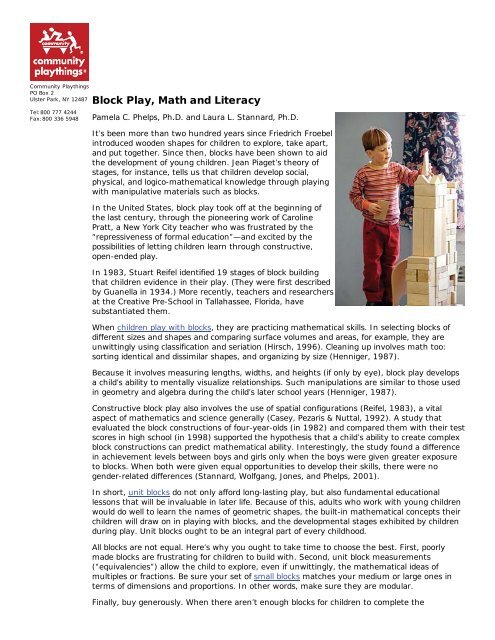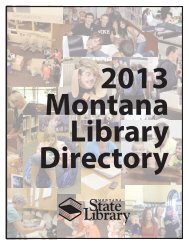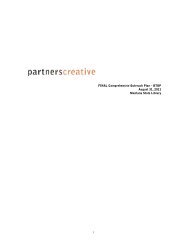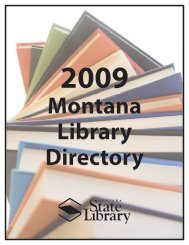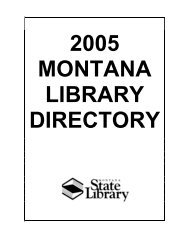Article: Block play, math, and literacy
Article: Block play, math, and literacy
Article: Block play, math, and literacy
- No tags were found...
Create successful ePaper yourself
Turn your PDF publications into a flip-book with our unique Google optimized e-Paper software.
Community Playthings<br />
PO Box 2<br />
Ulster Park, NY 12487<br />
Tel:800 777 4244<br />
Fax:800 336 5948<br />
<strong>Block</strong> Play, Math <strong>and</strong> Literacy<br />
Pamela C. Phelps, Ph.D. <strong>and</strong> Laura L. Stannard, Ph.D.<br />
It’s been more than two hundred years since Friedrich Froebel<br />
introduced wooden shapes for children to explore, take apart,<br />
<strong>and</strong> put together. Since then, blocks have been shown to aid<br />
the development of young children. Jean Piaget’s theory of<br />
stages, for instance, tells us that children develop social,<br />
physical, <strong>and</strong> logico-<strong>math</strong>ematical knowledge through <strong>play</strong>ing<br />
with manipulative materials such as blocks.<br />
In the United States, block <strong>play</strong> took off at the beginning of<br />
the last century, through the pioneering work of Caroline<br />
Pratt, a New York City teacher who was frustrated by the<br />
“repressiveness of formal education”—<strong>and</strong> excited by the<br />
possibilities of letting children learn through constructive,<br />
open-ended <strong>play</strong>.<br />
In 1983, Stuart Reifel identified 19 stages of block building<br />
that children evidence in their <strong>play</strong>. (They were first described<br />
by Guanella in 1934.) More recently, teachers <strong>and</strong> researchers<br />
at the Creative Pre-School in Tallahassee, Florida, have<br />
substantiated them.<br />
When children <strong>play</strong> with blocks, they are practicing <strong>math</strong>ematical skills. In selecting blocks of<br />
different sizes <strong>and</strong> shapes <strong>and</strong> comparing surface volumes <strong>and</strong> areas, for example, they are<br />
unwittingly using classification <strong>and</strong> seriation (Hirsch, 1996). Cleaning up involves <strong>math</strong> too:<br />
sorting identical <strong>and</strong> dissimilar shapes, <strong>and</strong> organizing by size (Henniger, 1987).<br />
Because it involves measuring lengths, widths, <strong>and</strong> heights (if only by eye), block <strong>play</strong> develops<br />
a child’s ability to mentally visualize relationships. Such manipulations are similar to those used<br />
in geometry <strong>and</strong> algebra during the child’s later school years (Henniger, 1987).<br />
Constructive block <strong>play</strong> also involves the use of spatial configurations (Reifel, 1983), a vital<br />
aspect of <strong>math</strong>ematics <strong>and</strong> science generally (Casey, Pezaris & Nuttal, 1992). A study that<br />
evaluated the block constructions of four-year-olds (in 1982) <strong>and</strong> compared them with their test<br />
scores in high school (in 1998) supported the hypothesis that a child’s ability to create complex<br />
block constructions can predict <strong>math</strong>ematical ability. Interestingly, the study found a difference<br />
in achievement levels between boys <strong>and</strong> girls only when the boys were given greater exposure<br />
to blocks. When both were given equal opportunities to develop their skills, there were no<br />
gender-related differences (Stannard, Wolfgang, Jones, <strong>and</strong> Phelps, 2001).<br />
In short, unit blocks do not only afford long-lasting <strong>play</strong>, but also fundamental educational<br />
lessons that will be invaluable in later life. Because of this, adults who work with young children<br />
would do well to learn the names of geometric shapes, the built-in <strong>math</strong>ematical concepts their<br />
children will draw on in <strong>play</strong>ing with blocks, <strong>and</strong> the developmental stages exhibited by children<br />
during <strong>play</strong>. Unit blocks ought to be an integral part of every childhood.<br />
All blocks are not equal. Here’s why you ought to take time to choose the best. First, poorly<br />
made blocks are frustrating for children to build with. Second, unit block measurements<br />
(“equivalencies”) allow the child to explore, even if unwittingly, the <strong>math</strong>ematical ideas of<br />
multiples or fractions. Be sure your set of small blocks matches your medium or large ones in<br />
terms of dimensions <strong>and</strong> proportions. In other words, make sure they are modular.<br />
Finally, buy generously. When there aren’t enough blocks for children to complete the
structures they have in mind, it not only frustrates them, but constrains them developmentally.<br />
Both writers are educational consultants at the Creative Center for Childhood Research <strong>and</strong><br />
Training in Tallahassee, Florida. www.cccrt.org<br />
Print this page<br />
International Sales<br />
© 1997-2011 Community Products, LLC


